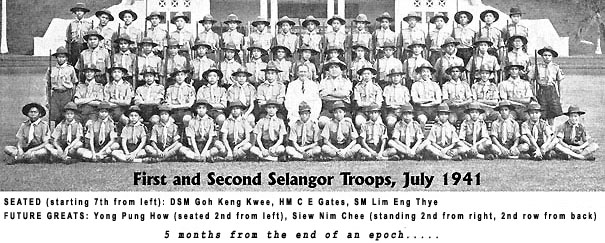 n 1933, seemingly unrelated distant events were unfolding. The German
Nazi party was elected into power in the Weimar Republic that year. This was
followed a year later by the establishment of the Third Reich under Adolf
Hitler with earth-shattering consequences by the end of the decade. To the East,
the puppet-state of Manchukuo was celebrating its first anniversary, with the last
Qing emperor, Pu Yi, as its nominal head, while power effectively resided with
the Japanese who had captured Manchuria in 1932. The ensuing expansion of the
Japanese across East Asia is a history too well-known to be reiterated here. At
the risk of sounding highly specious, it appears that 1933 was a pivotal year
in the formation of new structures that were to significantly chart the course
of history. A "new order" was sweeping through the world in the early to mid
1930’s, and organisation structures of political entities were clearly affected.
n 1933, seemingly unrelated distant events were unfolding. The German
Nazi party was elected into power in the Weimar Republic that year. This was
followed a year later by the establishment of the Third Reich under Adolf
Hitler with earth-shattering consequences by the end of the decade. To the East,
the puppet-state of Manchukuo was celebrating its first anniversary, with the last
Qing emperor, Pu Yi, as its nominal head, while power effectively resided with
the Japanese who had captured Manchuria in 1932. The ensuing expansion of the
Japanese across East Asia is a history too well-known to be reiterated here. At
the risk of sounding highly specious, it appears that 1933 was a pivotal year
in the formation of new structures that were to significantly chart the course
of history. A "new order" was sweeping through the world in the early to mid
1930’s, and organisation structures of political entities were clearly affected.
Even in the arena of ideas, there was also a "new order" sweeping through the world and Malaya. Since 1929, the Great Depression had seen massive unemployment and economic slump - phenomena which prompted a revolution in economic thought, as Michael Kalecki and John Maynard Keynes published their seminal works in 1932 and 1936 respectively. Domestically, the administration of Malaya, including the High Commissioner of the Federated Malay States from 1929, Sir Cecil Clementi, (not to be confused with Sir Cecil Clementi Smith, Governor of the Straits Settlements 1887-1890, and one of the founders of the V.I.) was embroiled in heated debate on the merits of decentralisation. Whether locally or internationally, people were thinking about new ways for solving their problems and for carrying out their functions effectively and efficiently. After all, this was what "new order" was supposed to achieve.
In the V.I., the Scouting movement underwent a momentous transformation in 1933.
ORGANISING NEW TROOPS
As of 1932, the First Selangor Scout Troop was in early 1933 divided
into two sections, A and B, for ease of training. Cumbersome planning and activities would
have been the consequences of the burgeoning Troop, were it not for the decision
to partition it. DSM Mr Ganga Singh was placed in charge of section 1A with SM

 Mr Lim Eng Thye as another Scout Master, while SM Mr Goh Keng Kwee helmed section
1B with SM Yoong Khee Hong as another Scout Master.
Mr Lim Eng Thye as another Scout Master, while SM Mr Goh Keng Kwee helmed section
1B with SM Yoong Khee Hong as another Scout Master.
A historic decision that has since charted the course of the V.I. Scouting movement was made in April 1933. At the suggestion of Mr H.R. Carey, the District Commissioner (and later, the V.I. Headmaster in 1934), the Victoria Institution’s two sections (of the same Troop) were formally split to form two separate Troops. Sections A and B were renamed the First and Second Selangor Troops, with 40 Scouts in the First Troop and 30 Scouts in the Second, and five Officers in total staffing both Troops. These two Troops have been in continuous existence since then, except for a short hiatus during the Second World War, when they continued to serve their homeland with pride. More on that later.
So how were members distributed between the two Troops in 1933? All Scouts of the First Troop had to pass the Second Class tests before they could become members of the Troop. Thus, in policy, those with lesser qualifications (except the leaders) such as the Second Class, Tenderfoot and recruits, belonged to the Second Troop. In fact, with the exception of the Patrol Leaders and Patrol Seconds, practically all the members of the Second Troop were recruits (those not having a Tenderfoot badge) in 1933. Effectively, this meant that the First and Second Selangor Troops were differentiated along the lines of badgework sequencing. However, this policy was to change a few years later. Some time around 1935, the First and Second Selangor Troops became Troops of equal standing so each had their share of higher qualified Scouts (such as those with the First Class badge) and those new Scouts who had just acquired their Tenderfoot badge. In fact, a decree was issued for both Troops by the Courts of Honour in 1938 that the Scouts of both Troops should have the Second Class badge, or at least be working towards it. Effectively, no recruit could become a member of First and Second Selangor Troops. This was made possible by the establishment of another Troop, called the Recruit Troop, in 1935.
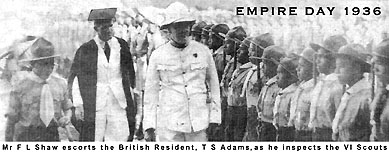
Placed under the leadership of ASM Ghazally b. Ahmad, the Recruit Troop was formed as an experiment. The Troop was to comprise of the boys from the V.I. feeder schools who wished to become Scouts. The members of the Recruit Troop were not strictly ‘fledgling’ members as some of them were already Scouts of their former schools. In other words, the Recruit Troop also consisted of members who had gained their Tenderfoot badge - the ‘non-recruits’. Nonetheless, the bulk of the Recruit Troop’s work was indeed devoted to preparing its recruits for the Tenderfoot badge while re-training other Scouts to re-familiarise them with the basics of Scouting knowledge. What happened after training and gaining the Tenderfoot? These members were then re-allocated into the First and Second Selangor Troops (where they continued training for the Second Class and higher badges), a practice that was terminated in 1939. From that year onwards, the Recruit Troop, belying its namesake, operated as a full-fledged Troop, training its members not just for the Tenderfoot but also for higher badges such as the Second Class badge. However, this independent existence was short-lived. After the Second World War, nothing more was heard about this Recruit Troop.
Democracy was practised in the running of the Troops. The yearly Court of Honour (COH) which consisted of Patrol Leaders, would vote for the Troop Leader, usually from among the previous year’s Patrol Leaders. It must be remembered that before World War Two, there was no such distinction as Boy Scout and Senior Troops in Malaya. Often the V.I. Troop Leader would be the most experienced or most qualified among all the Scouts, evidenced by the length of his membership as a V.I. Scout or his possession of a First Class and, many a time, the King Scout badge. In the COH’s, responsibilities would be allocated for different sections of administration. A typical categorisation of duties which was typical to both First and Second Selangor, as occurred in 1940, was as follows:
- Troop log and register
- Troop subscriptions
- Scout equipment
- Camping materials
- Badge secretary
- Scout library
- Swimming captain
- Scout room
At the helm of the V.I. Troops, besides the COH’s, were the Scout Masters. After the split occurred in 1933, SM Mr Lim Eng Thye took charge of the First Selangor Troop while SM Yoong Khee Hoong was placed in charge of the Second Selangor Troop, with newly promoted DSM Mr Goh Keng Kwee (formerly just an SM) supervising and helping both Troops. Truly, continuity of service offers the benefit of SM’s knowing their charges well and being familiar with the best training techniques for the boys. Both SM Mr Lim and DSM Mr Goh epitomised such continuity, serving the Scouts for a very long period. SM Mr Lim took the helm of First Selangor from 1933 up until (and after) the Second World War, while Mr Goh Keng Kwee led the Second Selangor (besides still overseeing all the V.I. Troops!) after SM Yoong left for Batu Gajah in 1936. There were other Scout Masters who came and went, such as SM Mr G.C. Tacchi who was placed in charge of the Recruit Troop in 1938 and DSM L. Lewis who assisted DSM Mr Goh in supervising all the V.I. Troops. Particular mention needs to be made of a certain ADC Mr E.M.F. Payne, who like DSM Lewis, helped DSM Mr Goh in overall supervision. ADC Mr Payne left for Malacca High School in 1938, but no one knew then that he would subsequently rise to become the Commissioner of Scouting in Malaya and, after the war, the Headmaster of the V.I.
SEPARATE BUT TOGETHER
The two V.I. Scout Troops have not always been mutually exclusive
of each other, and the twain DID meet on many occasions. As has been noted, the First
Selangor Troop was initially designated for First Class holders, while Second Selangor
for lesser badge holders. As such, it would have been necessary for periodic
re-allocations of members - those from Second Selangor who had gained the Second
Class would graduate into First Selangor, while some of those in First Selangor
with the First Class would be appointed as Patrol Leaders in Second Selangor. In
short, it is more accurate to think of both troops existing for chronological
placement rather than boys staying put in one Troop. Nonetheless, this need for
re-allocation ceased after the two Troops became Troops of equal standing, each
with its share of Second Class and First Class Scouts. In fact, some of the First
Class Scouts from both Troops were appointed as Patrol Leaders in the Recruit Troop
for purposes of training the recruits. In addition to this, there was a single Court
of Honour in charge of both the V.I. Troops. In short, inter-Troop competitiveness
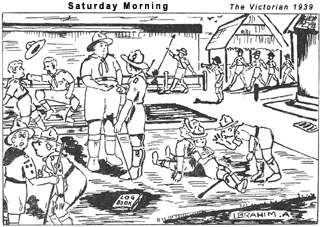 was rather thin in those early days. Of course, this was not to deny that some
competitiveness did exist. Observe the Kellam Cup competition. Continuing the
tradition started in the mid 1920’s, the competition pitted the patrols of the V.I.
Troops in areas of Scouting proficiency. The elements judged varied from year to year.
For example, in 1938, the COH decided that the Kellam Cup was to be awarded to the
first Patrol whose members were all Second Class Scouts.
was rather thin in those early days. Of course, this was not to deny that some
competitiveness did exist. Observe the Kellam Cup competition. Continuing the
tradition started in the mid 1920’s, the competition pitted the patrols of the V.I.
Troops in areas of Scouting proficiency. The elements judged varied from year to year.
For example, in 1938, the COH decided that the Kellam Cup was to be awarded to the
first Patrol whose members were all Second Class Scouts.
One major event which saw the V.I. Scouts co-operate very closely was the Beamish Cup competition. This was a contest for the trophy donated by the former DC Mr Beamish. The object of the award was to find the school with the greatest number of smart and efficient Scouts, the total number of boys in the school and the educational standard of the school being taken into consideration. On Monday 17 July 1933, the V.I. Scouts successfully defended the Beamish Cup won in the previous year and in 1930, leaving the Kajang High School in second place, and the M.B.S. in eighth. It was a day event but by no means were such things as drill, badges and Scoutcraft displays the sheer result of overnight perspiration. Rather, success required grinding at the mill all through the year; in other words, success at that one day event could only be ensured by consistency of abilities. Those who judged the competition were DC Mr H.R. Carey, Deputy Camp Chief for Malaya A.R. Westrop, ADC M.A. Akbar and DSM T.R. Abraham. The V.I. Scouts gained 421 marks out of a possible total of 500 from the following categories:
- General Turn Out
- Troop and patrol drill
- First and Second Class Scouts and Badges
- Scout Room, Log Book and Patrol Book
- Percentage of Attendance
- Display (including typical campfire songs)
Arguably, the primary goal of the V.I. Scouts was not to emerge
numero uno among Scout Troops, but merely to live up to true Scouting ideals; in
other words, doing their best not for glory, but for the sake of Scouting itself.
Trying to win a competition merely means comparing oneself with others (even if
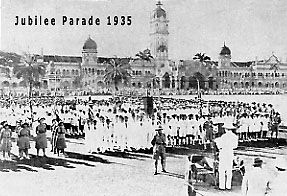 they are not the best role models), but trying to fulfil an absolute yardstick,
such as Scouting ideals, yields excellence that is timeless. Such must have been
what drove the V.I. Scouts to win the Beamish Cup again in 1934, 1935 and 1936.
they are not the best role models), but trying to fulfil an absolute yardstick,
such as Scouting ideals, yields excellence that is timeless. Such must have been
what drove the V.I. Scouts to win the Beamish Cup again in 1934, 1935 and 1936.
Another inter-Troop competition was the DC’s Efficiency Banner, which was presented by the DC Mr H.R. Carey for the first time in 1933. In that inaugural year, 14 Scouts from both Troops represented the V.I. between 21 to 24 August at Castle Camp, Rifle Range Road (now Kem Kota Raya on Jalan Padang Tembak). DSM Goh Keng Kwee was in charge. Unlike the Beamish Cup which was a day competition, the Banner involved a camp where various Scoutcraft competitions were also held. In the 1933 competition, the V.I. Scouts excelled themselves to win the Banner, gaining 628 marks out of 800 from the following categories:
- Construction of bivouacs, huts etc
- Camp site and gadgets
- Inspection, uniform, cleanliness etc
- Knotting relay (4 scouts per team)
- Message relay (1 patrol of six)
- Trestle building (1 patrol of six)
- First aid (1 patrol of six)
- Tracking/ Sand track problem (2 PL’s only)
- Kim’s Game (2 Patrol Seconds only)
- Pop-gun questions (1 PL, 1 Second and 1 Tenderfoot)
- Estimation of heights, distances etc (TL)
- Semaphore signalling competition (4 stations)
- Chart and compass race (1 team of four)
They won the Efficiency Banner again in 1935. Without the strong support of the V.I. Headmasters, many of the achievements of the V.I. Scouts would not have materialised. For example, the V.I.’s participation in the 1933 Efficiency Banner was in part due to Mr F.L. Shaw’s generosity in alloting to the Scouts part of the proceeds from the School Concert organised by the V.I. Musical and Dramatic Society. When Mr Shaw left the School in 1936, he received the ‘Thanks Badge’ on 7 June, in recognition of his services to the Scout movement in the V.I. and Selangor. Truly the Headmasters were very involved in Scouting activities. The 1941 Victorian records that in a ceremony on 8 November, the Headmaster presented badges won by the Scouts, and after the presentation congratulated the Troops on another excellent year.

Besides the Headmasters, many other people were credited for the achievements of the V.I. Troops. In the 1938 Victorian, the Scouts record the appreciation to Mr G.C. Tacchi, Mr H.L. Barnett and several other gentlemen who put forward the idea that fencing should be introduced among the V.I. Scouts. Fencing kits - including foil, glove and mask - were bought by ten keen Scouts at $7.50 a set. Under the eagle eye of Mr Barnett (and later Mr Grace from the Traffic Department), who kindly spared his valuable time from 4.30 p.m. to 7.30 p.m. every Tuesday, the Scouts practised their fencing. Results came quickly when the Scouts put up a commendable fencing performance during the Scout Show in 1938. Deservingly, Mr Barnett was presented with a 'Thanks Badge’ when he left for England at the end of that year. Others who lent support to the Scouting movement included Old Boy Dr Chua Boon Teck, who had been giving lectures on Ambulance work since the 1920’s, and Mr Chia Chin Yam who coached the boys in swimming. In mentioning the help of so many non-Scouts, one also should not forget the role of the wives of the Scout Masters. Besides allowing their husbands to devote so much of their time to Scouting, these wives also occasionally contributed their talents, such as Mrs Goh Keng Kwee, who was recorded as preparing food for a Second Class Camp organised by the First Selangor Troop during the Easter of 1939.
A KNOT AROUND THE HANDKERCHIEF
Lord Baden Powell, in Scouting For Boys, suggested that each Scout tie a reef knot on his handkerchief or Scout scarf to remind him to perform at least one good turn every day. But such reminders were unnecessary for the V.I. Scouts who were glad to perform more than the ‘recommended’ share of good turns. Thus, community service abounded:
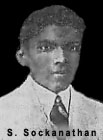
 Distances, Starman, Stalker or Tracker. Such training was made possible by the
availability of qualified instructors and good facilities. Both DSM Goh Keng Kwee
and SM Lim Eng Thye were members of the St John’s Ambulance Service, most
advantageous for First Aid training. As well, the First Class Scouts also had a
large role in training and passing the Tenderfoots; surely passing on knowledge
from the seniors to the juniors has always been a V.I. characteristic!
Distances, Starman, Stalker or Tracker. Such training was made possible by the
availability of qualified instructors and good facilities. Both DSM Goh Keng Kwee
and SM Lim Eng Thye were members of the St John’s Ambulance Service, most
advantageous for First Aid training. As well, the First Class Scouts also had a
large role in training and passing the Tenderfoots; surely passing on knowledge
from the seniors to the juniors has always been a V.I. characteristic!  said "...there were some scouts from the lower classes who showed great
tendencies to be what is known among scouts as ‘badge-hunters’. ‘Badge-hunting’
may be all right in that scouts, by bluffing or by learning by rote facts from
Scouting for Boys, Boy Scout Tests, and other manuals, can gain
red and white All-Round Cords and can display showers of badges to gaping admirers.
But the spirit of scouting is lost. It is indeed disappointing to see such
a view being taken in this troop and all not above reproach in this matter should
learn more about the aims of the movement...". Before alarms start ringing
and the reader gets an impression that badgework is completely repugnant to
Scouting, perhaps a comment is in order. Pung How’s comment referred to the
disagreeableness of the method of badge-taking, not the idea of badge-taking
in itself. Scouts should aim for badges, but in a way that helps them internalise
(as opposed to rote-learn) Scouting skills and Scouting ideals. They should not
ignore the forest for the trees. Yong Pung How himself was well-decorated, having
earned the First Class badge and also becoming a PL. Today, he is the Chief
Justice of Singapore, the highest judicial officer of the land. (See
said "...there were some scouts from the lower classes who showed great
tendencies to be what is known among scouts as ‘badge-hunters’. ‘Badge-hunting’
may be all right in that scouts, by bluffing or by learning by rote facts from
Scouting for Boys, Boy Scout Tests, and other manuals, can gain
red and white All-Round Cords and can display showers of badges to gaping admirers.
But the spirit of scouting is lost. It is indeed disappointing to see such
a view being taken in this troop and all not above reproach in this matter should
learn more about the aims of the movement...". Before alarms start ringing
and the reader gets an impression that badgework is completely repugnant to
Scouting, perhaps a comment is in order. Pung How’s comment referred to the
disagreeableness of the method of badge-taking, not the idea of badge-taking
in itself. Scouts should aim for badges, but in a way that helps them internalise
(as opposed to rote-learn) Scouting skills and Scouting ideals. They should not
ignore the forest for the trees. Yong Pung How himself was well-decorated, having
earned the First Class badge and also becoming a PL. Today, he is the Chief
Justice of Singapore, the highest judicial officer of the land. (See
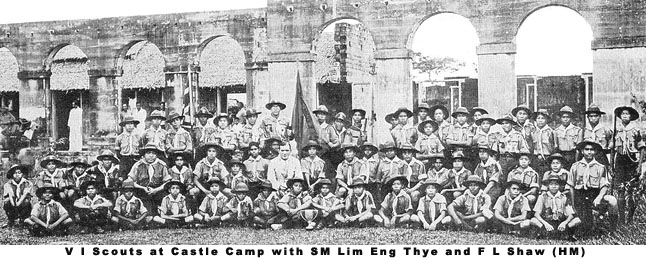
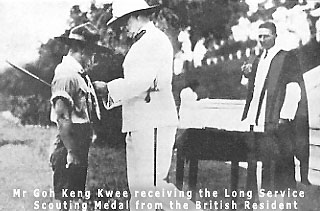 Shaw, the British Resident Mr T.S. Adams was also present. There was an inspection,
and an Ambulance Display by the V.I. Troops. Indeed, Mr Adams was closely linked
to the Scouts as he was the President of the Scout Association. Besides the
Residents, the Scouts were often visited by the District Commissioners, such as DC
Mr H.S. Duncan.
Shaw, the British Resident Mr T.S. Adams was also present. There was an inspection,
and an Ambulance Display by the V.I. Troops. Indeed, Mr Adams was closely linked
to the Scouts as he was the President of the Scout Association. Besides the
Residents, the Scouts were often visited by the District Commissioners, such as DC
Mr H.S. Duncan.
